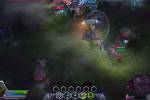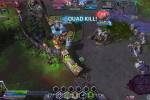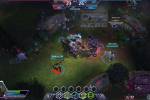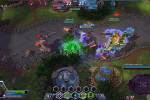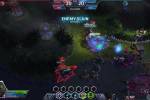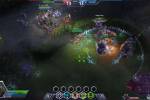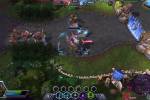Heroes of the Storm Review
For our review of Blizzard’s new MOBA, Heroes of the Storm, we took out quite a few hours to give an extensive and deeper insight into the game that has just entered open beta with the release due at the beginning of next month. For those unfamiliar the game features a all-star cast of your favourite characters from the various Blizzard titles from over the years, both heroes and villains, players will fight in team based battles across seven different objective-based maps. Already extremely popular over Twitch and played by quite a few popular YouTubers, it was high time we took a look at the game ourselves to see just what all the fuss was about.
Lore wise (like anyone really cares with a MOBA) is that the Nexus is a place where all worlds collide and champions are summoned forth to battle against each other to try and control, led by Uther Lightbringer (pretty much one of the main protagonists from the Warcraft series) players into the game as Commander Raynor from StarCraft II and can go through the tutorial as he guide you step-by-step on the different features as you go up against Diablo (from the Diablo series). The tutorial was pretty slick and simple, quickly getting you up to speed with some of the newer features and functions and highlighting some elements that players of MOBA will be all too familiar with. From stuff that is the same players will find themselves choosing from multiple different characters that fall into one of four different roles: Assassin (DPS), Warrior (Tank), Support (Heals/Buffs) and the Specialists who have a whole bunch of tricks up their sleeves that give them more miscellaneous functions. Maps are typically broken down into three traditional lanes, scattered around the “jungle” areas are a variety of mercenary camps, though with these if they are defeated the mercenaries actually join your waves of minions and try to push a lane, tower defences that will target enemies and finally the ultimate win objective of destroying the enemy Core, inconveniently located in the enemy base. Combat is essential same, using the mouse to move your character and targets and activating attacks with the QWE and R keys, as well as others if players unlock skills beyond their basics and “R” Heroic ability.
Those are the key similarities, however is quite a few major differences that (for at least for us) are what are going to set the game apart from other MOBA and has successfully managed to get rid of a lot of the clunky mechanics we didn’t like about them. First and foremost there is no gear/item buying to upgrade your character in battle; an extremely frustrating mechanic that was quite a hurdle for new players to fully understand how to maximise their hero’s potential. Instead players will earn XP from destroying structures, killing minions and taking down players, but it is communal team XP that level the entire team up and every three levels the entire team gets to upgrade their skills or unlock new abilities. Furthermore, this happens automatically and can be done in the field so players don’t have to return to base unless they need to heal/regen mana or do a quick base defense against any attacking enemy. Heading back to base and then making your way back towards the front line where the action is happening was always a tedious chore, this has been removed as players can spawn mounts when out of combat to move around the map quickly, further removing some of the frustrating and slow paced elements of other MOBA.
Lane and base defences are also different, typically being made up of two towers/turrets with a gate in between them that will allow Allied players to pass through but blocks enemy players and minions and so to push the lane players must take out at least the wall to keep moving. The number of defences in the game to play depends on the layout and size of the map, with large maps having many “towns” between both bases that have a number of structures including a mana well to heal up and replenish depleted manner, convenient for a quick to heal when near the front line without having to teleport back to your base with your hearthstone.
The maps themselves are completely different and probably the biggest difference between HotS and the other MOBA on the market, the main difference being the unique secondary objectives for each map. Whilst the aim of the game for both teams is always to destroy the enemy Core, the way they go about this can be completely different, whether trying to gather up Mercenaries, push and pull down a lane or focus on completing the maps unique objective. The objective is typically fall into two camps: collecting resources or capturing points, each of which will trigger an event on the map that will benefit this successful team and help destroy structures. For example in the Sky Temple there are two ancient temple areas with statues that must be awoken, defeated and then the point taken, which if Don will start to constantly fire lasers across the map at the enemy structures. Similarly players on Dragon Shire battle over control of two separate points and when one team controlled both points they can try to summon the Dragon at a central statue that will turn the player into a powerful boss with awesome attacks and high levels of hit points and armour.
The resource collecting objectives mainly work towards summoning gaining the services of a boss that will obliterate the enemy defences, whether playing on the Haunted Mines where players must head into an underground mine map and defeat and undead skeletal army to collect their skulls, with 100 skulls available once all are dead both teams automatically summon a Grave Golem that will march from their base down the lanes to the enemy base. Depending on how many of the 100 skulls a team collects will depend on how strong the Golem is; when destroyed the Golem falls into a pile of bones and after a time the undead army respawns in the mines, skulls are collected again, and the Golems rise in the place where the last fell! Similarly the Blackheart’s Bay has players fighting mobs and destroying chests to gain gold doubloons that they can hand in to the Ghost Captain at the centre of the map; when a team hands in the required number of coins the Captain will start to fire cannon balls from his pirate ship at the enemy defences, however in this game players keep hold of coins and will drop them if they are killed and so managing when your team breaks from attacking/defending to head to the middle of the map is all part of the strategy (and only a fool goes alone and chances the enemy taking them out and stealing their coins… so we learned… multiple times…).
The characters are all pretty fun and unique and we managed to try out all of the Weekly Rotation picks, five random characters that can be played each week for free, as well as a few others using the Random character which gives you access to the entire roster that obviously doesn’t let you choose who you want to play levelling up, completing daily quests and getting your Heroes to level 5 and fighting in battles brings in a steady flow of gold coins that can be spent in the shop to unlock Heroes, skins and mounts, alternatively players can spend real cash. Of all the characters we played with say that Muradin was by far the easiest, a dwarven lightning hammer wielding warrior from Warcraft, he had pretty decent defences and not only was a heavy hitter but also had the ability to leap a great distance to slam down on enemies allowing him to chase them down if they try to run. The character we play the most was the faerie dragon Brightwing, a support ranged off-healer that could teleport and insta heal players with her Heroic as well as use her polymorph attack to transfor enemies into pigs and shutting them down for a few seconds. Without shadow of a doubt the hardest to play (and judging by the 10/10 complexity on the official website for the character) were The Lost Vikings, a trio of characters that we could (try to..) control independently as was the way in the original The Lost Vikings game, splitting them up and send them to different locations, fighting different enemies and even on Dragon Shire trying to take on both points and become the Dragon all on our own (within say were successful… just that we tried… over and over.) With no abilities of their own they were extremely squishy when in combat, but extremely fun to play and definitely a useful specialist role.
Coming to the game as a relatively inexperienced MOBA player we have to say that we found the game fun and extremely easy to get into, albeit playing solo can be difficult as there is very little guidance from a random team in comparison to playing with a group of friends (which we also tried later that night). Every so often you get random Acts where players seem to suddenly come together and know what they’re doing (though expect that this grows more common as players reach higher levels and are playing with other players who are more experienced). There are moments of gold and we came away with our fair share of war stories and will definitely be returning to the Nexus again. Our biggest criticism is that the Heroes are actually pretty expensive, particularly when compared to other MOBA games, but this is Blizzard we’re talking about so we’re not massively surprised; if players are willing to pay it… then they’ll charge it, but it does mean we expect anyone who wants to play the game seriously will have to shell out some cash at some point, particularly if they want permanent access to a handful of their favourite characters.
Heroes of the Storm Review
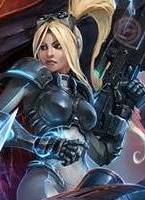
8.5
Overall Score
Graphics:
8/10
Gameplay:
8/10
Performance:
9/10
Plenty of characters to choose from, numerous strategic objective focused maps, easy to play
Heroes, skins and mounts in the cash shop are pretty expensive, some crashing issues (beta)
